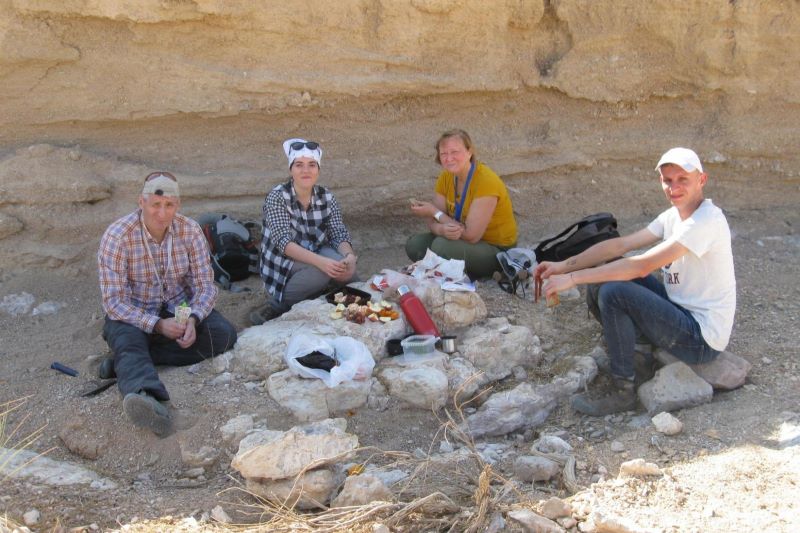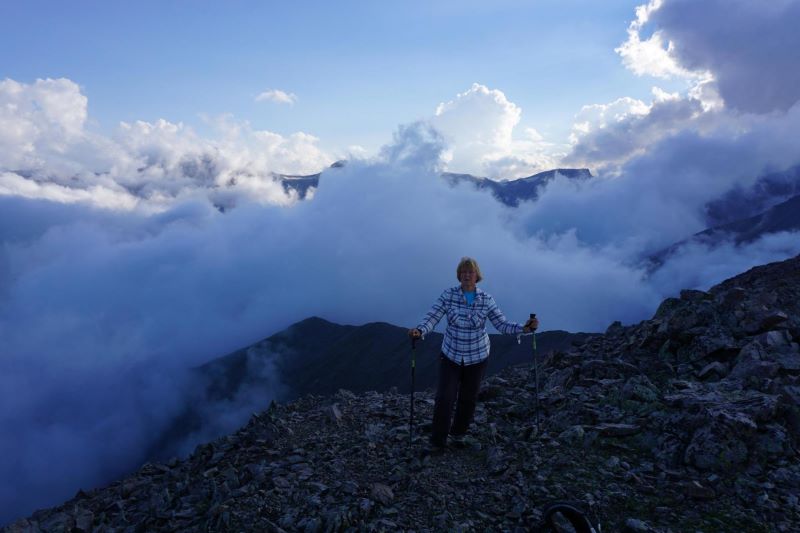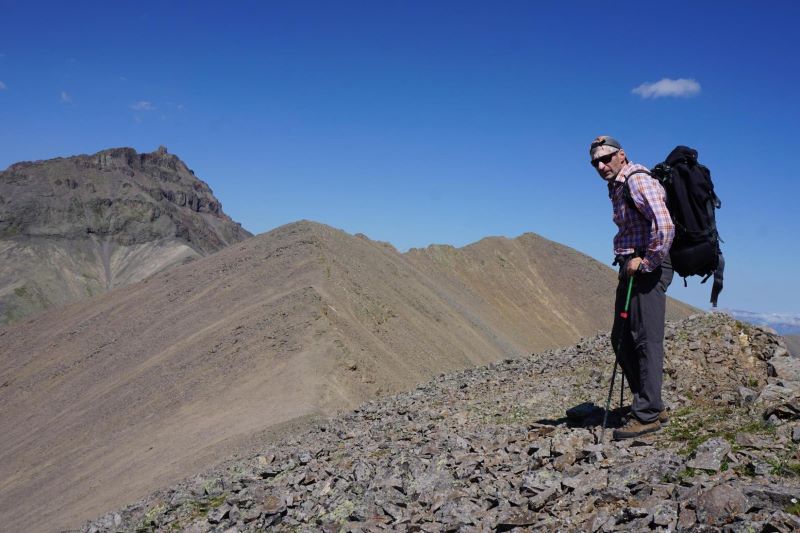| Weronika Cygan |
Pod koniec 2023 roku naukowcy podzielili się informacją o odkryciu karwowskiitu, Ca9MgFe2+0.5(PO4)7, który nazwali na cześć swojego zmarłego kolegi i wieloletniego pracownika Uniwersytetu Śląskiego prof. dr. hab. Łukasza Karwowskiego. Badacze podkreślają jednak, że minerał ten to zaledwie jedno z wielu ich odkryć, bynajmniej nie najdonioślejsze.
Zespół mineralogów z Wydziału Nauk Przyrodniczych UŚ, w którego skład wchodzą wybitni badacze: prof. dr hab. Evgeny Galuskin i prof. dr hab. Irina Galuskina, a także obiecujący młodzi naukowcy: dr Rafał Juroszek, dr Arkadiusz Krzątała, dr Dorota Środek i mgr Katarzyna Skrzyńska, wytrwale poszukują nowych minerałów o ciekawych właściwościach, które mogą znaleźć potencjalne zastosowanie w obszarach, takich jak medycyna, inżynieria materiałowa i inne.
Skarby w ziemi
Obecnie znamy blisko 6000 minerałów występujących w przyrodzie, ale na odkrycie i przebadanie czekają kolejne. Szacuje się, że natura może przed nami odsłonić ich jeszcze parę tysięcy, choć niektórzy domniemywają, iż to, co już znamy, stanowi raptem 8–10% wszystkich minerałów. – Sami tę obfitość obserwujemy. Kiedy udajemy się w teren, zawsze przywozimy nowe minerały. Rocznie odkrywamy od 4 do 5 gatunków mineralnych, ale w ubiegłym roku było ich aż 10 – stwierdza prof. Evgeny Galuskin.
Członkowie zespołu wybierają się na wyprawy do różnych krajów. Wybór danego obszaru zawsze poprzedza zgromadzenie informacji na jego temat. Naukowcy muszą ocenić szanse na to, czy w miejscu, do którego zamierzają się udać, mogą liczyć na ciekawe znaleziska. Na tym etapie ważne są wiedza i doświadczenie. Nawet jednak po skrupulatnych przygotowaniach trzeba liczyć na nieco szczęścia.
Dr Rafał Juroszek relacjonuje swoją pierwszą wyprawę do Izraela, która okazała się cenną lekcją:
– Teren był fascynujący, lecz bez doświadczenia nie wiedziałem, co powinienem zbierać. Po powrocie i sprawdzeniu materiału w laboratorium okazało się, że nie znalazłem nic wartościowego. Z każdą kolejną wyprawą w teren coraz lepiej potrafiłem ocenić, co warto zabrać, a co zostawić, bo nie będzie naukowo opłacalne.
Odkrywanie wyjątkowych właściwości
Siłą zespołu mineralogów z Uniwersytetu Śląskiego jest ich szeroka specjalizacja. Prof. Irina Galuskina śmieje się, że złośliwi mogliby uznać to za brak specjalizacji, ale przytacza wypowiedź prof. Franka Hawthorne’a z Kanady, który docenił dotychczasowy dorobek badaczy:
– Spodobała mu się nasza grupa, dlatego że pracujemy nad tak różnymi związkami chemicznymi. Zwykle naukowcy zajmują się wyłącznie jednym typem związków. W naszym przypadku są to pierwiastki rodzime, siarczki, tlenki, krzemiany i inne – właściwie cała klasyfikacja minerałów.
Na swoim koncie naukowcy z UŚ mają sporo fascynujących odkryć. W 2010 roku profesorowie Irina i Evgeny Galuskinowie natknęli się na minerał vorlanit, CaUO4. Badacze zaznaczają, że jest on pierwszym i jak dotąd jedynym minerałem o strukturze typu radiacyjnego. Oznacza to, iż jego pierwotna struktura uległa zmianom na skutek rozpadu promieniotwórczego. Późniejsza, zmodyfikowana struktura pozostała już stabilna i cechuje się nadzwyczajnymi właściwościami jako przewodnik elektronów. Po 4 latach od publikacji ukazał się amerykański patent (US 2014/0060643) wskazujący na wykorzystanie vorlanitu jako materiału fotoelektrycznego w panelach słonecznych.
Innym interesującym przykładem jest potencjalnie nowy minerał z grupy hydrokalumitu opracowywany przez doktorantkę mgr Katarzynę Skrzyńską. Może być wykorzystany np. jako substancja do immobilizacji chromu, który w środowisku naturalnym jest materiałem niebezpiecznym. Wciąż poszukuje się rozwiązań, z pomocą których można by go związać, by pozostał stabilny lub żeby uzyskać przejściowy materiał do dalszego przerobu.
Młoda badaczka wymienia właściwości minerału:
– Zmienia barwę w zależności od oświetlenia. Jeśli patrzymy na niego w świetle słonecznym, jest niebieskawoszary, a w sztucznym wydaje się bardziej różowy, fioletowy, co jest efektem podstawienia chromu w strukturze krystalicznej.
Członkowie zespołu podczas przerwy od prac prowadzonych na pustyni Negew | fot. Yevgeny Vapnik
Prof. dr hab. Irina Galuskina i prof. dr hab. Evgeny Galuskin w górach Kaukazu | archiwum prywatne
Cieńsze od ludzkiego włosa
Mineralodzy z UŚ podkreślają, że ponieważ często badają bardzo drobne minerały, praca z nimi bywa czasochłonna. W tym przypadku przyczyną jest brak odpowiedniego sprzętu i konieczność wysyłania próbek wymagających dodatkowych analiz do zaprzyjaźnionych ośrodków za granicą.
Podczas pracy w terenie można pozyskać pewne ogólne informacje na temat zebranego materiału, ale właściwa analiza odbywa się w laboratorium, gdzie eksperci przygotowują preparaty i obserwują je pod mikroskopami elektronowymi. Od rozmiaru minerału zależy, czy będzie się go dało przebadać przy użyciu sprzętu dostępnego na uczelni. – Nasza wydajność byłaby dużo wyższa, gdybyśmy na wydziale mieli do dyspozycji mikrosondę elektronową oraz dyfraktometr do monokryształów. Dzięki temu po znalezieniu nowego minerału i jego wyselekcjonowaniu moglibyśmy pracować na nim tu na miejscu – mówi prof. Evgeny Galuskin.
Zespół zgodnie twierdzi, że praca na tak drobnym materiale to kolejny aspekt wyróżniający mineralogów z UŚ na tle konkurencji. Mgr Katarzyna Skrzyńska uważa, że to najbardziej unikatowa część ich badań:
– Pracujemy na bardzo małych ziarnach minerałów. Przeciętna wielkość wynosi tyle, ile połowa grubości ludzkiego włosa. Problematyczne bywa również to, że często mamy tego materiału niewiele.
Badanie wytworów natury
Grupa pod kierunkiem profesorowie Iriny i Evgeny’ego Galuskinów zajmuje się minerałami znalezionymi w przyrodzie, ale analogi minerałów mogą być też syntetyzowane w laboratorium. Dr Rafał Juroszek zwraca uwagę na to rozróżnienie, które może służyć jako sposób weryfikacji odkryć: – Część tego, co sami badamy, została już wcześniej zsyntetyzowana i dopiero potem my lub inne osoby natknęliśmy się na dany minerał w środowisku. Jest też możliwy odwrotny kierunek działania – to znaczy, że my coś najpierw odkrywamy, a dopiero po pewnym czasie te minerały są syntezowane i obserwujemy, w jaki sposób zostały wykorzystane.
Mineralodzy nie mają wpływu na ewentualne zastosowanie znalezionego przez nich minerału, ale to oni dostarczają danych, które mogą zostać wykorzystane do produkcji nie tylko wspomnianych już paneli fotowoltaicznych, ale jakichkolwiek innych materiałów zaawansowanych. Nie wiedzą jednak, w jaki sposób i czy w ogóle dany minerał może być wykorzystany: zdarza się, że wyniki prac dotyczących zastosowania materiałów – analogów naturalnych substancji – pojawiają się po wielu latach czy dekadach od publikacji mineralogicznej.
Eksperci z UŚ przyglądający się naturalnym minerałom wskazują na jeszcze jedną różnicę pomiędzy nimi a naukowcami syntetyzującymi je w laboratoriach – chodzi o czystość materiału. Prof. Evgeny Galuskin dla przykładu wymienia skały pirometamorficzne, powstałe wskutek naturalnych pożarów: – Co było przez przyrodę wrzucone do tego pieca, tam wykrystalizowało. Z tego powodu znajdowane w tych skałach minerały są różnorodne i często prezentowane przez roztwory stałe.
W produkcji materiałów syntetycznych dużą uwagę zwraca się na „czystość” procesu, zatem znajdowane w naturze minerały z podstawieniami dodatkowych pierwiastków mogą nie cieszyć się zainteresowaniem komercyjnych podmiotów. Nie oznacza to jednak, że są bezużyteczne. Powstały w środowisku naturalnym minerał ma zapisaną w swoich właściwościach informację genetyczną, która może poszerzyć wiedzę na temat warunków i mechanizmów powstania skał.
Członkowie zespołu podczas prac w terenie | fot. archiwum prywatne
Realne odkrycia
Szum medialny wokół karwowskiitu jest ambiwalentnie postrzegany przez samych jego odkrywców. Rozbudził zainteresowanie dyscypliną oraz zespołem badawczym, a także przypomniał osiągnięcia naukowe prof. Łukasza Karwowskiego, na cześć którego został nazwany. Z drugiej strony mineralodzy zauważają, że na swoim koncie mają znacznie więcej odkryć o dużo większym potencjale, niecieszących się jednak takim samym zainteresowaniem gazet czy portali internetowych.
W swojej długoletniej pracy profesorowie Irina i Evgeny Galuskinowie odkryli odpowiednio 25 i 30 nowych minerałów, w sumie wspólnie uczestniczyli w opracowaniu ponad 70 minerałów. Młodsi stażem członkowie zespołu też mogą pochwalić się znacznymi osiągnięciami. Dr Rafał Juroszek, który odkrył już 4 minerały, zajmował się w trakcie doktoratu mineralizacją niskotemperaturową, a obecnie skupia się na pirometamorficznych minerałach akcesorycznych. Z kolei mgr Katarzyna Skrzyńska koncentruje się na zeolitach i już w tej chwili opisała 2 nowe minerały.
Choć obszar badawczy członków zespołu, jak sami przyznają, wydaje się dość niszowy (ze względu na małą liczbę badaczy zajmujących się mineralogią podstawową) i wymagający, to wiąże się z dużym prestiżem.
– Wszystko odbywa się też przy dużym nakładzie pracy, ale to są realne odkrycia naukowe – podsumowuje prof. Evgeny Galuskin.
Artykuł pt. „Odkrywając skarby przyrody – wyzwania mineralogów” został opublikowany w lutowym numerze „Gazety Uniwersyteckiej UŚ” nr 5 (315).









